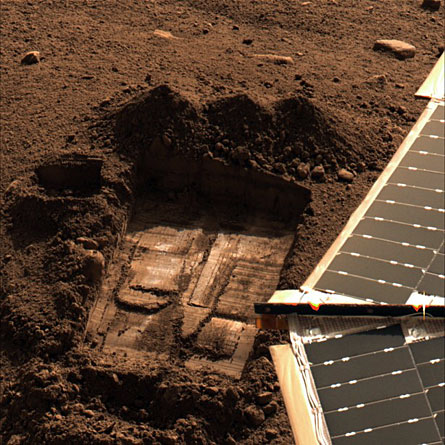- More than 2 years ago
Normal 0 false false false MicrosoftInternetExplorer4 One of the Phoenix Mars Lander’s instruments has “tasted” an unexpected compound in the soil of the Red Planet.
The chemical compound, perchlorate, is an oxidizing agent found in rocket fuel and is often considered a contaminant hazardous to human health. Still to be confirmed, the finding does not rule out the possibility that Mars could harbor some form of life, scientists said at an August 5 press briefing.

“These compounds are quite stable,” said Peter Smith of the University of Arizona in Tucson and the principal investigator of the mission. “They are not likely to tear apart organic material, and so their presence does not limit the search for habitability in the icy soil of Mars.”
This response comes after a weekend of speculative media reports on the perchlorate find, suggesting that Mars could not harbor life because of the chemical’s presence. But the discovery is neither good nor bad for the prospects for life on Mars, Smith said, pointing out that in Chile’s Atacama Desert, some microbes use oxygen from naturally occurring perchlorate for energy.
Traces of perchlorate were detected in MECA, the lander’s Microscopy, Electrochemistry and Conductivity Analyzer’s wet chemistry labs, which test for salts in the soil of the Red Planet. Two tests confirmed the existence of the chlorine-oxygen compound, which commonly exists in salt form with iron, calcium or magnesium.
Trying to confirm the result, the scientists looked for signatures of oxygen and chlorine when baking a soil sample in the lander’s “sniffing” instrument, TEGA, the Thermal and Evolved-Gas Analyzer. One sample did show traces of oxygen. But so far the instrument has yet to get a whiff of chlorine.
The scientists note, however, that not all salt compounds containing perchlorate give off chlorine. The team is also not sure whether the compound is native to Mars or a contaminant from the lander’s own rocket boosters.
The data analysis is still in an intermediate stage, which is why the Phoenix Lander team was holding off on announcing the find, Smith said.
But if the team confirms the presence of perchlorates as part of a naturally occurring salt on Mars, it will trigger studies to determine if areas other than the northern arctic regions show traces of the compound. And, said Michael Hecht, lead scientist for MECA, the find could potentially keep future graduate students busy for a long time.







